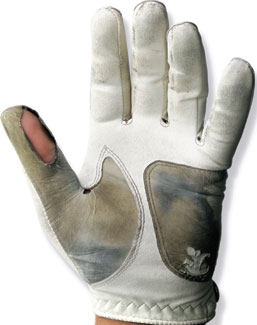Josh’s Tips & Tricks: Let me give you a hand with something
Welcome
Hello and welcome to this weeks tips & tricks.
It’s been a great week here at Windmill Leisure. The sun is shining, the golf courses are open and you lot have been practicing on the range and short game area. It’s been great to see everyone again and I’ve had a busy week coaching and fitting.
This week I would like to guide you through some key points about the golf glove. Why you should wear one, what you can tell from your glove, and which ones are best for you.
Why?
So why should you wear a golf glove?
A golf glove is not required when you play golf but they are made and worn by the best players in the world for a reason. Your hands are the only connection between you and the golf club and therefore are the controller of the shaft and clubface. If you hold the club wrong, have the wrong size glove, or don’t wear a glove the likelihood is you’re not going to have enough grip on the handle.
The golf glove is usually worn on the lead hand (left hand for a right handed player and vice versa). A glove is tackier than human skin and therefore increases traction and reduces the risk of the club slipping in the players hand.
I often get asked how tight a player should hold their clubs. The answer I give is just tight enough so the club won’t come out of your hand when you swing. Too tight and you increase the tension through the body, limiting body movements, too loose and the hands don’t have control of the clubface.
What’s your glove looking like?
Your glove can tell you a lot about the way you hold the golf club so lets have a look…

As you can see here the glove looks worn in a few places. We do sometimes get people returning gloves because of the “quality” however the problem often lies in the way the player holds the club. I for example only ever need to change my glove when it looks scruffy, not when it has holes in!
Worn out palm pad
This is the most common glove-wear pattern. A worn-out palm is caused by holding the club in the palm of the hand instead of at the base of the fingers. Gripping this way leads to leaked power/distance and a tendency to spin the ball left to right. This grip can lead to a glove wearing out within one round or one range session! Another key point here is how the grip pressure is maintained in the swing. If the player partly lets go of the club with their left hand in their swing, the top of the grip is likely to rub against the glove again causing tears.
Worn out thumb
A worn out or tear on the thumb can be caused by poor placement and also an incorrect grip pressure. I often see peoples veins popping out of their arms when they’re gripping the club too tightly. The thumbs on the grip should only be gently resting and therefore not creating too much friction. Again too little pressure or wrong placement could cause the thumb to move during the swing again causing the glove to wear down quickly.
Which glove to choose
Gloves come in all kinds of materials and and there’s not necessarily any right or wrong when it comes to choosing one. It’s important to firstly get the correct size. The glove should fit like a second layer of skin and at first may feel tight. As long as it isn’t cutting off your circulation, tighter is better. If a glove is too big, the grip will move around in your hand and therefore you don’t have perfect control off the clubface.
Choosing a material is important and this can differ from person to person. If you want a more durable and more of an all weather glove, a synthetic material will be better. If you want better feel and better feedback a premium leather glove will be better. There are rain gloves which can also be worn in the summer when the palms can get a bit sweaty. The moisture is resisted and the material of the glove allows you to grip the rubber handle without slipping.

What next?
If you don’t wear a glove or would like some advice on gloves please come and ask us. We have a large selection of gloves in stock and would like to get yours to “fit like a glove”. Having a new glove with good grip will help relieve pressure in the hands improving your game.
If your glove suffers from any of the symptoms described and you would like me to check your grip get yourself booked in for a lesson. I will happily guide you through the fundamentals and hopefully improve your golf! You could also save some money on gloves in the long run…
Cheers,
Josh

